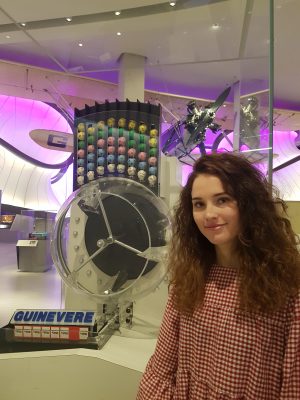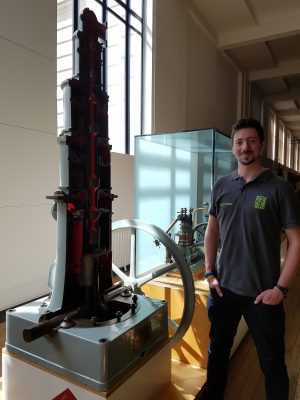For International Museum Day we spoke to staff from across the Science Museum to find out what makes the Museum so special to them. We asked what their favourite object was and why they chose it. Read on for a look at the people and the objects that make the Museum such a unique place.
Guinevere, 1994 from Mathematics: The Winton Gallery:
Dominique, Masterplan Collections Assistant

“I have a personal connection with ‘Guinevere’ as I installed it back in October 2016 for Mathematics: The Winton Gallery at the Science Museum. The task that ‘Guinevere’ performs is an ancient statistical task that we’ve had the technology to do for thousands of years. I love that despite the mechanical simplicity of ‘Guinevere’ when the UK’s National Lottery was first broadcast, millions of viewers were glued to their television sets with all eyes focused on those famous brightly coloured balls.”
People have been playing games of chance since before recorded history. Archaeologists have found evidence that early people used certain animal bones as rudimentary dice. But it was not until the 17th century that the mathematics of chance was understood. It is no coincidence that the world’s most talented mathematicians often used the throw of the dice to help work out the complexities of probability theory. Gambling helped them think through their mathematical ideas. We have been playing the National Lottery in the UK since 1994, when Prime Minister John Major set up the money-raising scheme and the BBC broadcast the first weekly draws using machines like ‘Guinevere’.
The Chemistry Bar from Wonderlab: The Equinor Gallery:
Liz, Explainer

“The Chemistry Bar in Wonderlab: The Equinor Gallery is my favourite part of the gallery. When I was studying Marine Biology at university I realised how fundamental chemistry is to informing our understanding of the world. Be it how organisms in the deep ocean live off the process chemosynthesis rather than photosynthesis, or even just what chemical compounds make up the world around us. At the Chemistry Bar we offer the opportunity to literally hold chemistry in your hands – it’s an unforgettable experience and inspires people to be curious and learn more. It’s also my favourite place in the Museum as I get to do what I love – presenting and interacting with the public, and even though I’m an Explainer I always learn something new from our visitors too.”
Wonderlab: The Equinor Gallery is the UK’s biggest interactive science gallery. The permanent gallery features unique exhibits, specially-commissioned artworks, explosive demonstrations and immersive experiences led by the Museum’s talented team of science communicators, Explainers, to inspire visitors of all ages to wonder at the science and mathematics that shape our lives. With over 50 exhibits across seven zones, visitors to the gallery will explore the incredible phenomena that occur around us every day, with topics as diverse as sound, forces, light, electricity, maths, matter and space. Wonderlab is also home to three live demonstration areas (including the Chemistry Bar) and a 120-capacity showspace inspired by the Royal Institution’s world-renowned Faraday Theatre.
Ford Model-T, 1916 from Making the Modern World:
Steve, Security Officer

“The ‘Ford Model T’ is a special object for me as the gallery it’s housed in Making the Modern World is the first one I worked in within the Museum. I’ve always had a personal connection with Ford cars, the first car I ever bought was a Ford! When my parents first moved to London from the West Indies the company everyone wanted to work for was Ford, so this object also reminds me of them and the start of their new lives in the UK.”
With the Model T car Henry Ford established the manufacturing system that made his name a byword for mass production. His vast Highland Park plant in Detroit, USA, was one of the industrial wonders of the 20th century and was visited by political leaders and industrialists from around the world. Ford declared, ‘the man who places a part does not fasten it … the man who puts on the nut does not tighten it’.
Through this ruthless subdivision of labour, and by applying mass production techniques on a vast scale, the Ford company created, with the Model T, a simple and affordable car. This brought motoring within the reach of a huge new market. Every step was taken to simplify and speed up production, including the decision in 1914 to paint cars only in black. The design was first introduced in 1908 and, by 1927, when the Model T was phased out, over 15 million had been produced. This was the largest production run of any car design in the first half of the 20th century.
Willans triple-expansion engine, c.1887 from the Energy Hall:
Fergus, Volunteer

“I’ve loved coming to the Science Museum ever since my grandfather took me here as a child. He was an engineer and shared his passion for his work with me. I’ve also always been interested in design and the different ways you can use materials to create something new. ‘Willans triple-expansion engine’ is my favourite object as I suppose it combines these two subjects but also it shows the ingenuity people are capable of. I love the sheer complexity of the design but also the determination of engineers like Willans to create more efficient energy sources. Even today, processes like this that harness steam power are used across the energy sector from nuclear power to coal and gas.”
The Energy Hall traces the remarkable story of steam and how it shaped the world we live in today. Steam has been the driving force behind British industry for 300 years. Without it, the Industrial Revolution could never have happened. Even now, steam provides 75% of the electricity we use every day. Willans central-valve engines were mainly used in early electricity generating stations. This one was built according to Peter Willans’ patent of 1884 and he used it as an experimental engine. It is full size and cut open so you can see how it worked. Engines like these were later replaced by steam engines.
One comment on “International Museum Day”
Comments are closed.
Great to see the security sraff get a mention, great guys and gsls